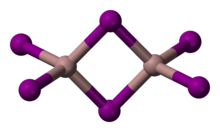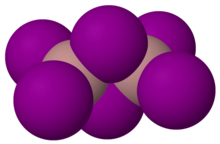|
'''Gallium(III) iodide''' is the ] with the ] ]]<sub>3</sub>. A yellow hygroscopic solid, it is the most common iodide of gallium.<ref>{{cite book|author=Donges, E. |chapter=Gallium(III) Iodide|title=Handbook of Preparative Inorganic Chemistry, 2nd Ed. |editor=Brauer, G. |publisher=Academic Press|year=1963|place=NY, NY|volume=1|pages=846}}</ref> In the ] method of growing crystals of ] uses iodine as the transport agent. In the solid state, it exists as the dimer Ga<sub>2</sub>I<sub>6</sub>.<ref>{{cite journal|doi=10.1002/zaac.200600008|title=Chemischer Transport fester Lösungen. 27. Mischphasenbildung und chemischer Transport im System Zn ''Se''/Ga ''As''|year=2006|last1=Brünig|first1= C.|last2=Locmelis|first2=S.|last3=Milke|first3=E.| last4=Binnewies|first4=M.|journal=Zeitschrift für Anorganische und Allgemeine Chemie|volume=632|issue=6|pages=1067–1072}}</ref> When vaporized, its forms GaI<sub>3</sub> molecules of D<sub>3h</sub> symmetry where the Ga–I distance is 2.458 ].<ref>Haynes, p. 9.23</ref> |
|
'''Gallium(III) iodide''' is the ] with the ] ]]<sub>3</sub>. A yellow hygroscopic solid, it is the most common iodide of gallium.<ref>{{cite book|author=Donges, E. |chapter=Gallium(III) Iodide|title=Handbook of Preparative Inorganic Chemistry, 2nd Ed. |editor=Brauer, G. |publisher=Academic Press|year=1963|place=NY, NY|volume=1|pages=846}}</ref> In the ] method of growing crystals of ] uses iodine as the transport agent. In the solid state, it exists as the dimer Ga<sub>2</sub>I<sub>6</sub>.<ref>{{cite journal|doi=10.1002/zaac.200600008|title=Chemischer Transport fester Lösungen. 27. Mischphasenbildung und chemischer Transport im System Zn ''Se''/Ga ''As''|year=2006|last1=Brünig|first1= C.|last2=Locmelis|first2=S.|last3=Milke|first3=E.| last4=Binnewies|first4=M.|journal=Zeitschrift für Anorganische und Allgemeine Chemie|volume=632|issue=6|pages=1067–1072}}</ref> When vaporized, its forms GaI<sub>3</sub> molecules of D<sub>3h</sub> symmetry where the Ga–I distance is 2.458 ].<ref>Haynes, p. 9.23</ref> |
|
Gallium triiodide can be reduced with gallium metal to give a green-colored ]. The nature of this species is unclear, but it is useful for the preparation of gallium(I) and gallium(II) compounds.<ref>{{cite journal|doi=10.1039/b501310k|title="GaI": A versatile reagent for the synthetic chemist |year=2005 |last1=Baker |first1=Robert J. |last2=Jones |first2=Cameron |journal=Dalton Trans |issue=8 |pages=1341–1348 |pmid=15824768 }}</ref><ref>{{cite journal|doi=10.1039/b613669a|title='GaI': A new reagent for chemo- and diastereoselective C–C bond forming reactions |year=2007 |last1=Green |first1=Shaun P. |last2=Jones |first2=Cameron |last3=Stasch |first3=Andreas |last4=Rose |first4=Richard P. |journal=New J. Chem. |volume=31 |pages=127–134 }}</ref> |
|
Gallium triiodide can be reduced with gallium metal to give a green-colored ]. The nature of this species is unclear, but it is useful for the preparation of gallium(I) and gallium(II) compounds.<ref>{{cite journal|doi=10.1039/b501310k|title="GaI": A versatile reagent for the synthetic chemist |year=2005 |last1=Baker |first1=Robert J. |last2=Jones |first2=Cameron |journal=Dalton Trans |issue=8 |pages=1341–1348 |pmid=15824768 |hdl=2262/69572 }}</ref><ref>{{cite journal|doi=10.1039/b613669a|title='GaI': A new reagent for chemo- and diastereoselective C–C bond forming reactions |year=2007 |last1=Green |first1=Shaun P. |last2=Jones |first2=Cameron |last3=Stasch |first3=Andreas |last4=Rose |first4=Richard P. |journal=New J. Chem. |volume=31 |pages=127–134 }}</ref> |





